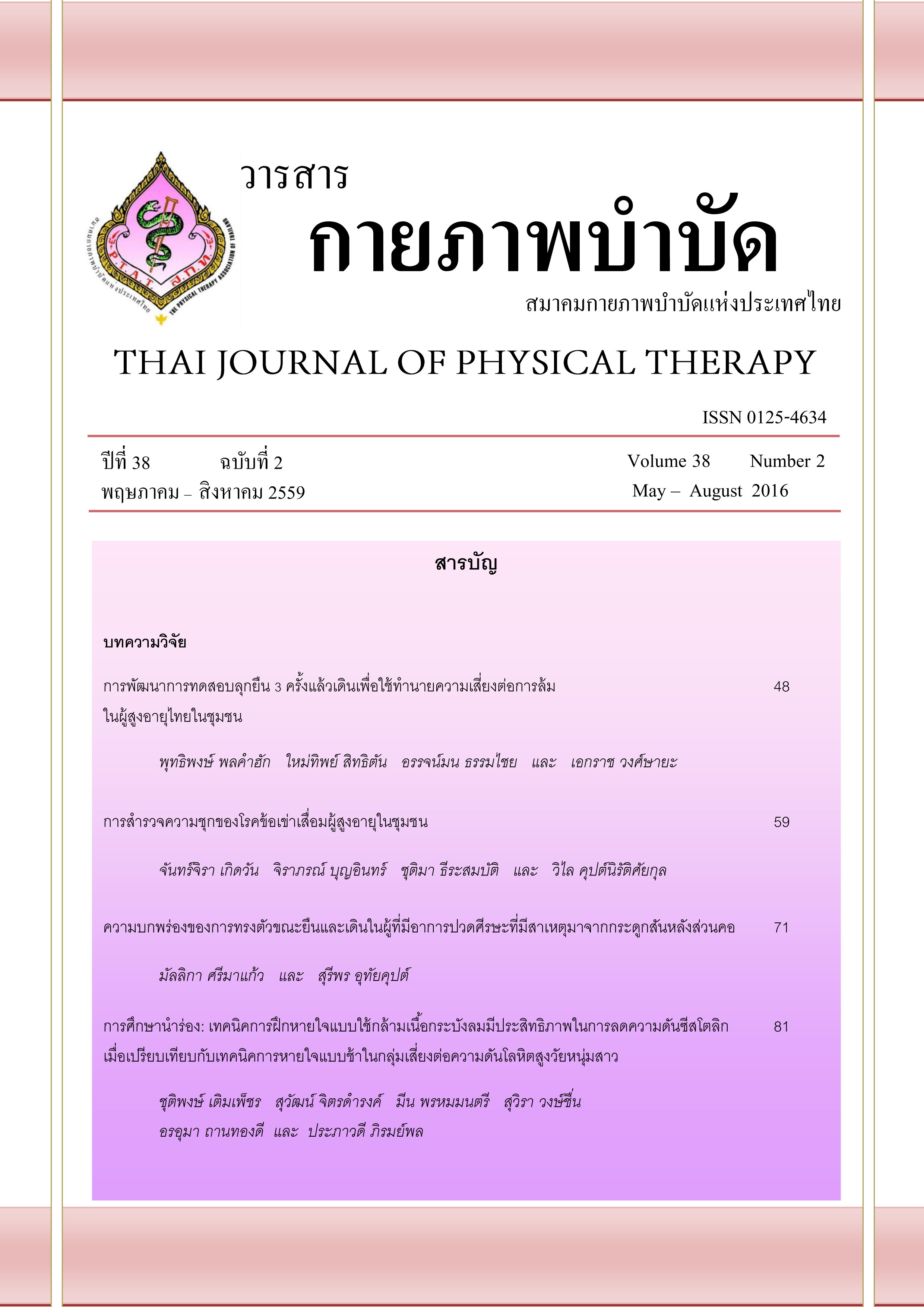การพัฒนาการทดสอบลุกยืน 3 ครั้งแล้วเดินเพื่อใช้ทำนายความเสี่ยงต่อการล้มในผู้สูงอายุไทยในชุมชน
Main Article Content
บทคัดย่อ
ที่มาและความสำคัญ: การทดสอบการลุกยืน 3 ครั้งแล้วเดิน (Three Times Sit and Walk test; TTSW) เป็นการทดสอบความสามารถทางกายที่ถูกพัฒนาขึ้นมาใหม่ เพื่อใช้ทำนายการล้มในผู้สูงอายุไทยในชุมชน อย่างไรก็ตาม ยังขาดข้อมูลสนับสนุนด้านความเที่ยงตรงของเครื่องมือ และค่าตัดแบ่งที่เหมาะสมในการนำไปใช้ในการทำนาย
วัตถุประสงค์: วัตถุประสงค์ของการศึกษานี้เพื่อพัฒนาและประเมินคุณสมบัติด้านการทำนาย เพื่อหาค่าตัดแบ่งที่เหมาะสมของการทดสอบ TTSW และเปรียบเทียบความสามารถในการทำนายการล้มของการทดสอบ TTSW กับการทดสอบมาตรฐาน
วิธีการ: อาสาสมัครผู้สูงอายุในชุมชน จำนวน 70 ราย อายุตั้งแต่ 60 ปีขึ้นไป โดยอาสาสมัครจำนวน 35 ราย เคยล้มอย่างน้อยหนึ่งครั้งในรอบหกเดือนที่ผ่านมา และ อีก 35 ราย ไม่เคยล้ม อาสาสมัครทั้งหมดจะได้รับการประเมินเบื้องต้นเกี่ยวกับข้อมูลพื้นฐานทั่วไป และถูกประเมินด้วยการทดสอบความสามารถทางกาย ได้แก่ การทดสอบ TTWS การทดสอบ Timed Up and Go test (TUGT) และการทดสอบ Five Times Sit-to-Stand test (FTSST)
ผลการศึกษา: ผลการศึกษาพบว่า การทดสอบ TTSW มีค่าตัดแบ่ง ≥ 12 วินาที และพบว่า การทดสอบ TTSW มีค่าความไว ความจำเพาะ และพื้นที่ใต้กราฟ อยู่ในระดับสูงที่สุด (ความไว ร้อยละ 80.00, ความจำเพาะ ร้อยละ 91.43 และพื้นที่ใต้กราฟ 0.87; 95%CI = 0.79-0.98) รองลงมาคือการทดสอบ TUGT และ FTSST (ความไว ร้อยละ 68.57 และ65.71, ความจำเพาะ ร้อยละ 80.00 และ 77.14, พื้นที่ใต้กราฟ 0.82; 95%CI = 0.72-0.92 และ0.77; 95%CI = 0.66-0.88 ตามลำดับ)
สรุปผลการศึกษา: การทดสอบ TTSW สามารถเป็นเครื่องมือทำนายความเสี่ยงต่อการล้มได้ โดยผลการศึกษาพบว่าหากผู้สูงอายุไทยในชุมชนใช้เวลาในการทดสอบ TTSW ตั้งแต่ 12 วินาทีขึ้นไป บ่งชี้ถึงการมีความเสี่ยงต่อการล้ม
Article Details
เอกสารอ้างอิง
2. El Haber N, Erbas B, Hill KD, Wark JD. Relationship between age and measures of balance, strength and gait: linear and non-linear analyses. Clin sci 2008; 114: 719-27.
3. Rubenstein LZ, Josephson KR. The epidemiology of falls and syncope. Clin Geriatr Med 2002;18:141-58.
4. Rubenstein LZ. Falls in older people: epidemiology, risk factors and strategies for prevention. Age ageing 2006;35: 37-41.
5. Poncumhak P, Insorn T, Prasittimet N, Manota P. The Pilot Study on the Risk of Fall Prediction in Thai Elderly Using Five Times Sit-to- Stand Test. Srinagarind Med J 2014; 29 :237-42.
6. Thiamwong L, Suwanno J. Risk Factors Related To Balance Impairment Among Rural Community-Dwelling Older Adults. J Police Nurse 2014; 6: 56-68.
7. Chantanachai T, Pichaiyongwongdee S, Jalayondeja C. Fall prediction in thai elderly with timed up and go and tandem walk test: a cross-sectional study. J Med Assoc Thai 2014; 97: 21-5.
8. Tiedemann A, Shimada H, Sherrington C, Murray S, Lord S. The comparative ability of eight functional mobility tests for predicting falls in community-dwelling older people. Age ageing 2008; 37: 430-5.
9. Whitney SL, Wrisley DM, Marchetti GF, Gee MA, Redfern MS, Furman JM. Clinical measurement of sit-to-stand performance in people with balance disorders: validity of data for the Five-Times-Sit-to-Stand Test. Phys ther 2005; 85:1034-45.
10. Wannapakhe J, Arayawichanon P, Saengsuwan J, Amatachaya S. Changes of functional ability in patients with spinal cord injury with and without falls during 6 months after discharge. Phys ther 2014; 94: 675-81.
11. Saensook W, Poncumhak P, Saengsuwan J, Mato L, Kamruecha W, Amatachaya S. Discriminative ability of the three functional tests in independent ambulatory patients with spinal cord injury who walked with and without ambulatory assistive devices. J Spinal Cord Med 2014; 37: 212-7.
12. Scott V, Votova K, Scanlan A, Close J. Multifactorial and functional mobility assessment tools for fall risk among older adults in community, home-support, long-term and acute care settings. Age ageing 2007; 36: 130-9.
13. Bloem BR, Valkenburg VV, Slabbekoorn M, Willemsen MD. The Multiple Tasks Test: development and normal strategies. Gait Posture 2001; 14: 191-202.
14. Poncumhak P, Sittitan M, Srithawong A. Inter Tester Reliability and Validity of the Three Times Stand and Walk Test (TTSW) in Healthy Adolescent. Thai J of Phy ther 2015; 37: 91-9.
15. Park SH, Goo JM, Jo CH. Receiver operating characteristic (ROC) curve: practical review for radiologists. Korean J Radiol 2004; 5: 11-8.
16. Akobeng AK. Understanding diagnostic tests 3: Receiver operating characteristic curves. Acta Paediatr 2007; 96: 644-7.
17. Fan J, Upadhye S, Worster A. Understanding receiver operating characteristic (ROC) curves. Cjem 2006; 8: 19-20.
18. Renfro MO, Fehrer S. Multifactorial screening for fall risk in community-dwelling older adults in the primary care office: development of the fall risk assessment & screening tool. J Geriatr Phys Ther 2011; 34:174-83.
19. Shumway-Cook A, Brauer S, Woollacott M. Predicting the probability for falls in community-dwelling older adults using the Timed Up & Go Test. Phys ther 2000; 80: 896-903.
20. Tinetti ME. Performance-oriented assessment of mobility problems in elderly patients. J Am Geriatr Soc 1986; 34: 119-26.
21. Berg KO, Wood-Dauphinee SL, Williams JI, Maki B. Measuring balance in the elderly: validation of an instrument. Can J Public Health 1992; 83: S7-11.
22. Shumway-Cook A, Baldwin M, Polissar NL, Gruber W. Predicting the probability for falls in community-dwelling older adults. Phys ther 1997; 77: 812-9.
23. Herman T, Giladi N, Hausdorff JM. Properties of the 'Timed Up and Go' Test: More than Meets the Eye. Gerontology 2011; 57: 203-10.
24. Tapanya W, Chamnongkich S. Relationship between lower limb muscle strength and single-leg sit-to-stand performance in young adults. Bull Chiang Mai Assoc Med Sci 2014; 47: 133-42.
25. Buatois S, Perret-Guillaume C, Gueguen R, Miget P, Vancon G, Perrin P, et al. A simple clinical scale to stratify risk of recurrent falls in community-dwelling adults aged 65 years and older. Phys ther 2010; 90: 550-60.


